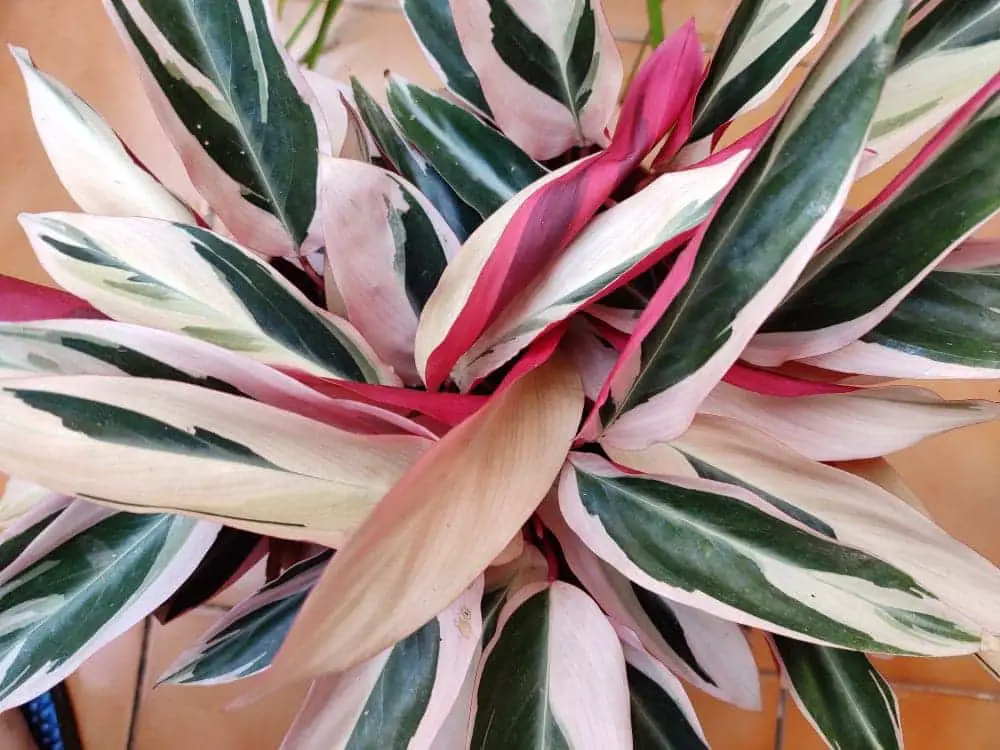The Stromanthe is a leafy tropical plant in the prayer plant family. These plants are unique in that they fold in on themselves at night.
They are eye catching with their full variegate leaves in striations of different pink hues. They require conditions that mimic those of a rainforest, so humidity, natural light, and soil moisture all play a role in their ability to thrive.
The Stromanthe can be a bit daunting for a beginner. The require a little more TLC than some common houseplants and are best for more experienced houseplant owners looking for a bit of challenge. If your Stromanthe’s leaves are turning yellow, there is certainly an underlying reason. You must discover what it is to save your plant.
The Stromanthe Plant
The Stromanthe Plant is originally from the depths of the Brazilian rainforest. During the day, their leaves unfurl, and they reach for the light. Because of this, they should be rotated frequently so they do not grow crooked. Flowers sometimes develop in the warmer months if the plant is kept outside, but it is the leaves that are the focal point of this plant. It is nontoxic to humans and animals, so families with pets and small children need not be concerned.
It grows to a mature size of two to three feet and does best in light soil with good drainage. They grow best in hot humid conditions that mimic the conditions of a rainforest.
Why Monstera Plants Gets Yellow Leaves
There are several reasons why the leaves of your Stromanthe plant may be turning yellow.
1. Moisture
Moisture is the most important aspect of caring for your Stromanthe plant. The main reason for yellowing leaves in this plant is imbalanced moisture in the soil and humidity. The soil always needs to remain moist but should never be waterlogged. Ideally, only the top inch of soil should be allowed to get dry. The Stromanthe can also be picky about the type and temperature of water used. It often does not thrive when watered with tap water, and it does not like chilled water either. They also require a great deal of humidity to thrive and do not do well in arid conditions.
2. Pests
Already stressed plants can be susceptible to infestation by a variety of common plant pests. These include: scale, mealybugs, and spider mites.
3. Temperature and Climate
The Stromanthe is a tropical plant and as such it prefers a climate that is similar to its home region. This means it thrives best in warm conditions between 65 – 85 degrees F with a lot of humidity. It does especially poorly in extremely dry conditions.
4. Lighting
Stromanthe require bright, indirect light. Direct sunlight will cause the plants leaves to burn, turning yellow of brown and even falling off completely. Conversely, too little light can also negatively impact your plant, coughing the leaves to become pale and yellowish.

Treatments
Moisture:
- Ensure your soil is always moist but never soaked.
- Only allow soil to dry up to the first inch.
- Water with spring water or distilled water at room temperature, not chilled.
- Since they require high levels of humidity, many people keep their Stromanthe’s in the bathroom where the steam from the shower will keep the air moist. If you choose not to do this, mist your plant weekly to provide extra moisture.
- Wipe your plant with a damp cloth, this will ensure the leaves are able to absorb as much moisture as possible.
- They dislike air conditioning intensely, so keep your plants far from your AC ducts and units.
Pests:
- Dust your plant periodically to deter pests from infesting it.
- If mealy bugs are present, remove them by hands then dab with an alcohol moistened cotton ball.
- Give your plant a shower with gentle pressure to wash away spider mites.
Temperature and Climate:
- Ensure plants are kept in an area where the temperature is between 65 to 80 degrees F.
- Do not keep your plant near air conditioning or heat vents. The dry hot and cold air pumped out by these units can cause their leaves to turn yellow, brown, or fall off.
Lighting Issues
- Do not place your plant in direct sunlight. Since these plants are used to growing on the rainforest floor, they need diffuse bright light and will burn if subjected to direct sunlight.
- Hang a sheer curtain or blinds from your window to reduce direct sunlight if your plant is near the window.
- Make sure your plant receives an ample amount of indirect sunlight, as they will also suffer for lack of light.
How to Take Care of the Yellow Leaves
You can prune away damaged leaves from the base of the plant. If the entire leaf is not damaged, you can carefully trim the leaf to remove the damaged section. Make sure you follow the natural lines of the plant. Never remove more than 30% of your plant at once. If a large portion of your plant is requires pruning or trimming, do it a little at a time.
It is also natural for some leaves to simply turn yellow or brown than fall off. If these are older leaves and your plant is otherwise healthy, this isn’t a cause for concern. It is part of the growth cycle of the plant for it to shed old leaves and replace them with fresh growth. So that’s that.
More like this: Yellow Alocasia Polly Plant Leaves
Conclusion
The Stromanthe can be a bit needy as far as houseplants go and likely isn’t the best plant for a beginner. For those with a green thumb and experience with plants, however they can be very reward plants, as their foliage is exceedingly beautiful.
When caring for a Stromanthe, remember that it can be very fussy about water. It needs to be kept in conditions that mimic the rainforest. Use room temperature distilled water or filtered water when watering, and ensure the soil is kept constantly moist and the plant is not exposed to very dry air.
Keep reading:
- Yellow Monstera Leaves – Reasons & Treatments
- Yellow Pothos Leaves – Reasons
- Yellow Aglaonema Leaves – Reasons & Treatment
Victoria is the owner and main author of hobby plants. She loves spending her free time in her garden planting and taking care of her plants. Victoria hopes you enjoy the content here!

